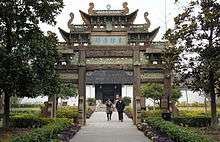Donglin Academy
The Donglin Academy (Chinese: 東林書院; pinyin: Dōnglín Shūyuàn; literally: "Eastern Grove Academy", Wade–Giles Tung-lin), also known as the Guishan Academy (龜山書院 Guīshān Shūyuàn), was a former Chinese educational institution in Wuxi, China. It was originally built in 1111 during the Northern Song dynasty and was where the neo-Confucian scholar Yang Shi (楊時) taught, but later fell into disuse and disrepair. The name "Donglin" was inspired by the Donglin Temple at the base of Mount Lu, Jiangxi. Yang Shi visited the Donglin Temple and felt that it was a good place for teaching. When he finished his scholarship, he travelled to Wuxi and saw that the layout of the Donglin Academy was similar to the Donglin Temple, so he taught at the site for 18 years. The academy was thus called "Donglin Academy".

In 1604, during the Wanli era of the Ming dynasty, Gu Xiancheng (1550–1612), a Grand Secretary, along with Gao Panlong (高攀龍; 1562–1626), a scholar, with fellow scholars Qian Yiben (錢一本) and Yu Kongjian (余孔兼) restored the Donglin Academy on the same site with financial backing from the local gentry and officials such as Ouyang Dongfeng (歐陽東風), the governor of Changzhou, and Lin Zai (林宰), the county magistrate of Wuxi. The academy gave its name to the resulting Donglin movement.
In 1626, the academy was brutally destroyed leaving only part of the stone memorial arch. The nowadays academy was a rebuilt during the Qing dynasty by the Yongzheng and Qianlong emperors to win the hearts of Han Chinese scholars living in Wuxi.[1]
The government of the People's Republic of China redecorated the academy from 1981–82.
References
| Wikimedia Commons has media related to Donglin Academy. |